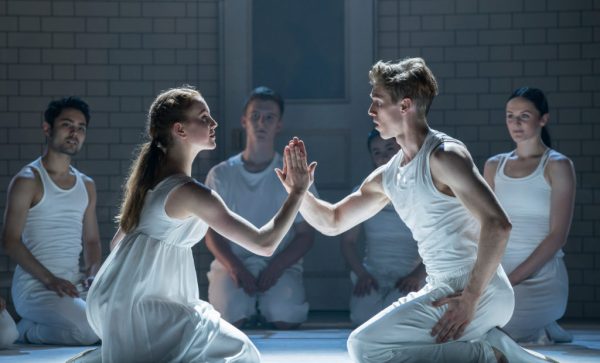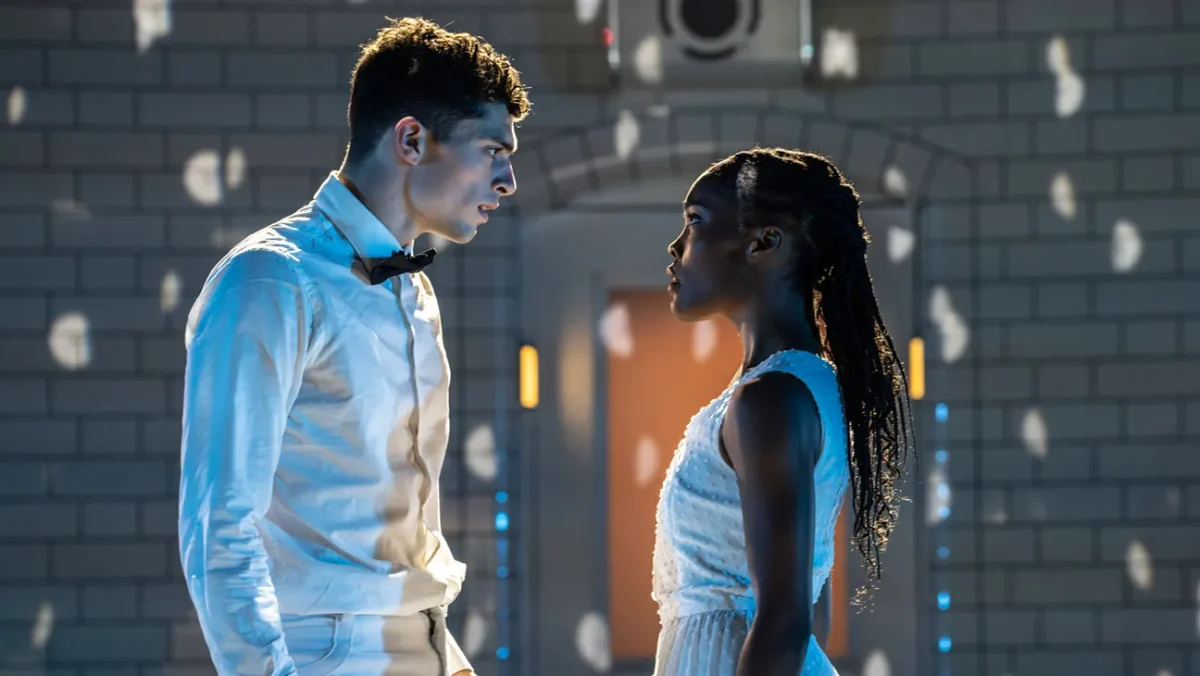Let’s face it: Shakespeare is dead. But Matthew Bourne’s contemporary ballet brings Romeo and Juliet back to life.

Something is wrong in the Verona Institute. From the moment the orchestra strings their first two bars—the dark, jarring theme of composer Sergei Prokoviev’s “Dance of the Knights”—it is clear that the sterile, white mental hospital and the patients trapped within it are at war with each other. Maybe it’s the patient’s spotless uniforms, or lifeless faces as they stack chairs in time to the music, but the opening number warns me to leave my preconceptions at the door—so that I can spend the next two hours glued to the edge of my seat.
The basic structure of Romeo and Juliet is “boy and girl meet, fall in love, get torn apart by circumstance, and die.” Director and choreographer Matthew Bourne uses Shakespeare’s plot as a scaffolding to build his own universe where the first law of nature is division. Boys and girls are separated by dormitory and activity, only allowed to march with each other. Under the fluorescent lights of day, each group bears the watch of their respective dean. Not everything is under control, though: Bourne introduces Juliet (Bryony Pennington) while she tries to avoid the sexual advances of Tybalt (Cameron Flynn), the Institute’s lead guard whose torment has recently extended from after-hours to broad daylight. The undercurrent of discord runs through every particle of energy on stage, as if too concentrated by its facade of navitie. Even the music is suppressed: Bourne mocks the arrangement of “Arrival of the Guests” with tinker-toy brittleness, instruments waiting to snap. Which they can’t.
Until the lights turn out, and all hell breaks loose. Girls dance with girls, boys wear skirts, skirts swish up and hands trail down. Teenage rage manifests in physicality, granting fluidity of movement when, in a whirlwind, Romeo (Jackson Fisch) and Juliet are thrown together under the shimmering light of the disco ball. From then on, it is clear that lighting controls choreography, and the shifting identities of each dancer are brought out in flashes when the lights dim.
This is the first element of brilliance in Bourne’s work. He captures the conflict at the heart of Shakespeare’s narrative and engulfs the audience in it, forcing them to reckon with its dynamics and agility. There are almost always multiple scenes staged at once, allowing me to spend bits of time from the perspective of one or a few individuals before shifting to those on the other side of the room. With the stage mostly empty of set pieces, the dancers and their emotions take their full breadth of space. This is only heightened when the stage is empty, as is the case for Romeo and Juliet’s three pas-de-deux (partner dances). There is nothing but dancing and music, from the violin that pulls Romeo across the railing of their dorm during their final kiss of the balcony scene or the flute that floats above them in the second act for their reunion. Every movement is electric, building physical and emotional tension to culminate in the final sequence.
In restructuring the ballet’s music, Bourne creates pockets of lightness to let secondary characters shine. Romeo’s arrival to the Institute is set to “Mercutio,” where he meets his newfound brothers Balthasar and Benvolio and immediately establishes camaraderie. Just like a well-timed punchline in the theater, the Montague parents’ code-switch from perfect public personas to detached mother and father is a recurring comedic respite to the complicated inner life of the hospital. Despite some dancers playing multiple roles, their distinct personalization of each character makes them individuals with whom the audience can form different relationships, perhaps a more difficult task than developing one character all the way through.
Character development is spectacular throughout the company. Pennington plays a lovely, complicated Juliet who grapples to reconcile the trauma of her past and the hope of her future, whose presence is simply magical when paired with Fisch’s eager and tender-hearted Romeo. My heart hammered in my ears as I watched Flynn’s Tybalt stalk around the stage, chasing Juliet in her nightmares. It amazes me that I sat entranced by the three of them—and the rest of the cast—for two hours without a word of dialogue. Each glance exchanged between each character transcended language, a testament to the intention and talent behind the choreography.
I could talk for hours about the technical aspects of this production. I’ve spent half my life experiencing and performing theatre and dance, and “Romeo + Juliet” is my first revelation of the power of collaboration in design. Every element works together, be it lighting or staging or sound. I sat completely still when Tybalt pulled the lights up on the disco, shattering the desperate freedom found in darkness. The soft golden sun through the bars of the dormitory gates broke my heart as Juliet held Romeo after an agonizing three weeks apart. This, I realized, is artistry: understanding how separate mediums combine to create an experience that is both timeless and fleeting.
And—of course—the story. This is not just Romeo and Juliet. It’s a commentary on the money that feeds institutions, the destructive spiral of sexual assault and the heartbreak of youth. I could spit phrases at you like the “mismanagement of mental health” and “toxic masculinity,” but out of context these words mean nothing. The point is that Bourne builds the narrative before you even realize it’s begun, like the symphony of an orchestra sweeping its way to a crescendo. It’s breathtaking. It’s brutal. It is genius, plain and simple, breathing vitality into a centuries-old story that renews Shakespeare’s place as a fixture in the artistic world in all its mediums.
A word of warning: Bourne’s work is not the easiest to follow. He is famous for using classic ballet scores like “Swan Lake” or “Sleeping Beauty” and choreographing them with a more contemporary style, exploring each work’s underlying themes. In this production, Tybalt (originally Juliet’s violent cousin) also functions as the count Paris, who Shakespeare wrote as her spurned fiance. Even with my solid knowledge beforehand, I had to piece together what was going on and who was on stage. In motion, the changes are sometimes too difficult to reconcile, leaving an otherwise stunning production with a serious downfall: it is not easily understood, and difficult to enjoy when trying to do so. Still, it’s worth a try.
If Bourne’s “Romeo + Juliet” didn’t close the day after I saw it the first time, I would spend thousands of dollars watching it over and over again. I’m now going to spend seven dollars for a monthly subscription to watch the professionally recorded production. If you need me, that’s where I’ll be.




